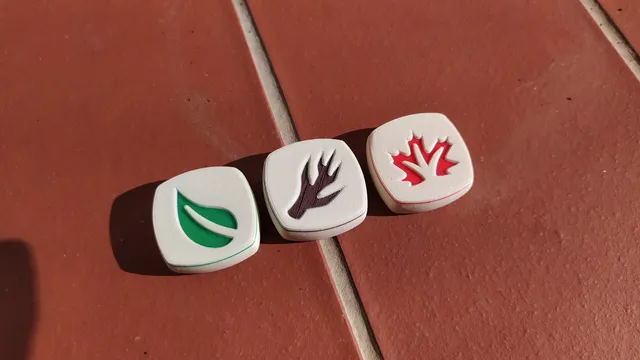
Abstract strategy game: Leaves
prusaprinters
LeavesLeaves is my original, never-before shared abstract strategy game.In the game, two players fight to have more leaves on the tree when the game ends.Each turn, new leaves are added to the tree, in an interesting fashion, pushing the already placed leaves around, creating a dynamic gameplay. And while all possible moves are very hard to keep track of, especially when thinking a couple of rounds ahead, the game is finite and no back-and-forth moves exist.From the beginning, Leaves was intended to fall into the ‘easy to learn, hard to master’ category. Let me know, how well I've accomplished that.See the PDF rulebook in files for more info. PrintI suggest you generate your own G-code. I included my G-code for informative purposes (printer, print time, …). Only for completeness I included all of my finetuned G-code. Your printer's specific needs will probably differ.What do you need to print for a game set10 pieces of one color (grn.stl)10 pieces of second color (red.stl)5 pieces of neutral color (log.stl/branch.stl/mix it up)The piecesThe pieces are 30 mm x 30 mm x 10 mm each.Log/BranchI have ended up with two variants for my tree (neutral) pieces. My printed set in the pictures has the branch.stl variant. You only need one variant, or you can mix it up.MaterialFor my printed set I selected PLA simply for the color choice. If PETG had decent color choice, I'd rather go for that. My prototype prints were mostly ASA (again for the color that I had readily on hand).Print settingsI have experience printing this on Prusa MK3S and Prusa MK3S+ & MMU2S.I was printing with PLA which had some warping issues. I addressed that in two ways: skirt as high as the model (draft shield) and lowering the fan speed (70%).My prints are at 0.2 mm layer, but you probably want to go as low as your patience allows.Color printIf you don't want to paint your pieces, color print is a great option.First I tried to change color for the layers that make up the outline of the images, but this failed due to the white-ish filament on top being too translucent. Also the resulting strip on the side of the piece was too thick and too close to the top (bottom).I ended up recoloring only the layer that makes up the base of the image and one more towards the center of the model to make the strip thicker (and to get a breather between changing the fillaments, I guess).I added a symmetrical strip for an interesting look. The strips on the side of the pieces make identifying the pieces a breeze when you have them mixed up in one bag.I have also included files that I used with a multi-material printer.OrientationPrinting the model oriented as-is is the easiest way to get this printed, but after a couple of test prints, I tried printing them upside down (image down). This together with the textured plate resulted in a beautiful finish on top. The images, which are an overhang, have an interesting diagonal hatching look that I liked. But printing these long stretches of overhang could cause problems (I had slight issues - every piece different).The multi-material prints in my opinion don't have any drawbacks when printed image-down. The multi-material files are therefore image-down by default.WeightMy prints (15% infill) use A2 steel nuts for additional weight - pieces with nuts weigh: 12.6 g while the normal pieces weigh: 3.9 g. The additional weight makes the pieces feel more substantial.Printing 100% infill is an option. According to slicer the weight of 100% infill pieces is over 9 g. Pieces that are too light might not be as enjoyable to play with.Nut holeThe nut hole files have an internal hole for an M10 DIN 562 square nut for added weight.While the fit is OK when inserting the nut, when the prints cool down, they rattle - some more, some less. I'd recommend using some sort of glue if that's an issue for you. My one test print, that was PETG, does not rattle.Nonessential settingsI use Hilbert curve on both the top and the bottom of the print. I feel that Hilbert curve + textured plate is the best at hiding print lines. Hilbert curve on the bottom of the tile will also very likely have a uniform resistance in all directions when slid across a surface (cocentric circles probably take this one, but they also were quite unsightly on my prototypes).Print timeFor a full set of 25 pieces at 30 minutes per piece, you are looking at a 12.5 hour print, not accounting for any pauses.When I was printing my own set I printed with 5 stops to swap fillaments and insert the nut. Even though I got the workflow optimized pretty well, it still added a substantial amount of time.If you are comfortable with printing multiple objects at once, you can probably make this process much more bearable. Somewhere around two 4 hour prints and one 2 hour print, totalling close to 10 hours with much less overall user interaction. Celebrating 42 downloads and 300 views!
With this file you will be able to print Abstract strategy game: Leaves with your 3D printer. Click on the button and save the file on your computer to work, edit or customize your design. You can also find more 3D designs for printers on Abstract strategy game: Leaves.
